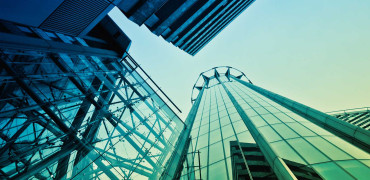We have now entered the age of the heat pump and are slowly seeing the end of gas being the dominant way of heating our buildings, especially with new, high temperature heat pumps that can literally replace a gas boiler, using the same basic infrastructure.
Whilst this is taking time to bed down in the residential market, which has its own challenges related to leaky housing stock, skills shortages and the high price of electricity compared to gas, the situation in the non-domestic sector is very different.
Commercial buildings in the UK contribute around a quarter of operational carbon emissions in the built environment, so they have a really important role to play if we are to reduce the environmental impact of our buildings in the coming years.
They are also more straightforward to decarbonise so offer the country some ‘low hanging fruit’ to keep us sated on the road to net zero.
Heat pumps can improve energy efficiency while lowering your carbon footprint
The future is already here
The UK is looking to decarbonise all sectors of the economy as the country looks towards reaching our legally binding net zero targets by 2050.
The built environment currently makes a significant contribution to our overall carbon emissions, meaning it is a crucial area to tackle when striving to reach this goal.
While in recent years there has been significant focus on ensuring these commercial spaces are constructed sustainably, around 80% of the buildings we will occupy in 2050 have already been built. This means we need to find ways of reducing the carbon footprint of the existing building stock now, if we are to reach these targets in future.
Low carbon retrofitting, where the systems providing heating, hot water and cooling are either upgraded or replaced to improve energy efficiency, offers a more straightforward, cost-effective way of adapting these spaces in comparison to demolish and rebuild. This will help ensure our commercial buildings are operating sustainably, and in line with targets for Net Zero.
Our buildings must be adaptable
The government is already introducing legislation designed to reduce the carbon impact of the built environment.
For example, the Minimum Energy Efficiency Standards (MEES) now requires all new and existing commercial buildings to have an energy performance rating of Grade E or above. These regulations are only set to tighten, with the government expected to commit to all buildings to be rated a minimum of Grade B by 2030.
The UK Net Zero Carbon Buildings Standard, developed by a group of leading industry organisations including RIBA and CIBSE, will also include performance targets for energy use, embodied and lifecycle embodied carbon in commercial buildings.
Investors are also beginning to take into account the green credentials of these spaces, while organisations continue to express an increased preference for leasing and purchasing more environmentally friendly buildings. This means buildings risk becoming ‘stranded assets’ and potentially becoming unlettable if they aren’t adapted to meet these regulatory requirements in the future.
Low carbon is the answer
While retrofitting our buildings to lower emissions can ensure they are operating in line with changing regulations, it can be difficult for building professionals to know where to start.
To meet this need, the UK Green Building Council has developed their ‘Delivering Net Zero: Key Considerations for Commercial Retrofit report. This outlines several key areas of consideration when embarking on a commercial retrofit project, starting with understanding the building and its specific requirements. This includes the greenhouse gas emissions associated with its operation and the performance of the systems installed.
Conducting a building assessment can then help identify any systems contributing to high carbon output, as well the scale of the project required. A light retrofit will only require adapting a specific aspect or building component, and so can be carried out while other areas are still in use. A deep retrofit involves making significant improvements or changes to building services, and may require a large-scale intervention such as change of occupancy. It’s therefore vital to plan for any potential limitations to retrofitting well in advance to minimise the amount of disruption caused.
Whole life carbon (WLC), the carbon emissions associated across a building’s entire lifecycle, is another important area to consider. This can help ensure the systems installed balance both operational (the carbon impact of the building being used) and embodied (the carbon used in construction and demolition) carbon, allowing the building to operate as efficiently as possible.
Selecting the right technology
Upon completing a building assessment, the next step is to opt for a solution that meets your building’s specific requirements.
A Hybrid Variable Refrigerant Flow (HVRF) system is able to provide quiet, energy efficient heating and cooling for a range of applications. The use of water as opposed to a refrigerant removes the need for leak detection in occupied spaces, reducing ongoing maintenance costs while also future-proofing buildings against upcoming changes to the F-Gas regulations. Its decentralised structure can also support a phased installation approach while the number of units can be expanded to meet demand, making it ideal for owners and managers wanting to minimise disruption to occupants.
Installing a heat pump can also improve the energy efficiency of your building. High temperature heat pumps such as the 40kW Ecodan QAHV can deliver hot water of up to 90°C, while lowering carbon footprint and providing significant cost savings. Owners and managers adopting a phased-out approach can also consider opting for a bivalent heat pump system, where the heat pump and gas boiler work in parallel but the former provides a higher proportion of heating to lower a building’s overall carbon emissions.
With buildings owners and managers increasingly having to adapt their spaces in line with changing environmental regulations, it is imperative the commercial sector is not left behind. By retrofitting these spaces with low carbon, energy efficient technologies, we can ensure these buildings are prepared to hit the government’s ambitious, but very necessary, Net Zero goal.
Martin Fahey is Head of Sustainability




